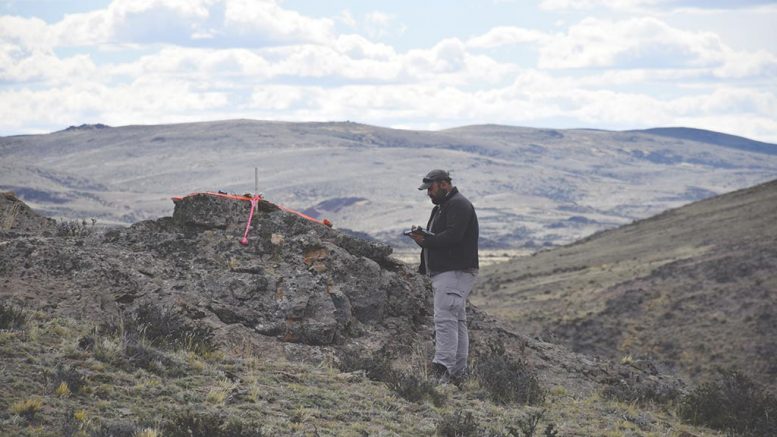Mirasol Resources (TSXV: MRZ; US-OTC: MRZLF) is about to do something it doesn’t do often: drill one of its own projects.
The Argentina- and Chile-focused precious metals project generator is in the middle of a $4.5-million exploration initiative at its gold-silver-copper projects in Chile and Nico gold-silver project in Argentina. It intends to spend $1.51 million exploring Nico alone, which it is permitting for a phase-one drill program in January 2019.
On top of that, three of the company’s joint-venture partners will spend at least $7 million across four of Mirasol’s projects in Argentina and Chile. All of this is happening during Mirasol’s financial year, which began on July 1, 2018.
“We’re sticking to that project-generation model for our core, large-scale, high-risk, high-reward projects,” Mirasol president and CEO Stephen Nano says in an interview with The Northern Miner, “but we also have a crop of projects, with high-grade mineralization at surface, and very near mine infrastructure.
“It’s a really sensible, risk-reward profile for us to be drill testing those kinds of projects, where even a modest discovery would create substantial value for our shareholders. Nico is one of those projects.”

Drillers at work on Mirasol Resources’ La Curva gold project in Santa Cruz, Argentina, which is under a joint-venture agreement with OceanaGold. Credit: Mirasol Resources.
Nico straddles a provincial gravel road that Pan American Silver (TSX: PAAS; NASDAQ: PAAS) plans to use to truck ore from its COSE and Joaquin silver properties through Nico to its nearby Manantial Espejo mine facility for processing.
The company is already doing surface work, including geophysics, geological mapping and geochemical sampling at Nico’s Aurora and Vittoria prospects to prepare them for drill testing. Over the past year, it has brought Nico’s Resolution target to drill-ready status — a 2 km long trend where channel samples taken in 2018 graded as high as 950 grams per tonne silver and 4.27 grams gold over 0.3 metre. The company will drill outcropping mineralization to see if it extends underground.
Mirasol is funding its exploration in part with the $8 million it raised during a private placement in June 2018.
Argentina is experiencing an economic crisis that has seen its currency fall to half the value it had a year ago. Inflation has also risen to 45.5% in October 2018 from 25.4% in January 2018.
“I’ve personally worked in Argentina now for 25 to 30 years, and, unfortunately, Argentina goes through these high inflation periods, but they never at any stage impacted our ability to explore or discover or operate in that country,” Nano says. “The perception of what’s happening in Argentina is probably much more significant than the reality of it for us at the moment.”
Nano says the company has seen a surge of interest in its Argentina projects, from first-tier precious metals producers all the way to juniors, as well as from companies’ operating mines in Argentina to those that aren’t, but want to get in.

Mirasol’s Nico gold-silver project in Santa Cruz, Argentina. Credit: Mirasol Resources.
“The financial issues Argentina as a country is facing aren’t impacting us at any level negatively,” Nano says, “and in fact are probably creating opportunities for us at this stage, because these companies are saying this is the time to come in and secure good projects.”
Still, Nano says Mirasol tries to balance Argentina’s financial risk with its Chilean portfolio. It intends to spend $1 million on early-stage exploration at its projects in the Chilean Miocene-Pliocene belt.
“The desire to do more deals with us on our project portfolio is stronger now than I’ve ever seen before,” Nano says.
“The companies that didn’t blow up their balance sheets with poor investments during the last boom have been making really good margins and have got the money to spend on exploration again, but none of them were spending on exploration over the last five or six years, so they had no project pipelines.”
Newcrest Mining (ASX: NCM; US-OTC: NCMGY) will spend $4.3 million exploring Mirasol’s Altazor gold project in northern Chile. It starts late this quarter with a surface-exploration program. It intends to follow up with an initial drill program targeted for 2019’s second quarter, permits pending. Newcrest can earn up to 80% of Altazor.
Hochschild Mining (LON: HOC; US-OTC: HCHDF) will spend $1 million over a year and a half at Mirasol’s Indra precious metal project in northern Chile. It has committed $370,000 to a December 2018 surface-exploration program that will define targets for 2019 drilling. Hochschild can earn up to 75% of the project.
OceanaGold (TSX: OGC; US-OTC: OCANF) will spend $1.6 million this year at the Claudia and La Curva precious metal joint ventures in Santa Cruz, Argentina. The spending includes a 3,000-metre drill program already underway at La Curva. It can acquire up to 75% at both La Curva and Claudia.
“There’s a small pool of projects for these companies to joint venture into, and Mirasol stands with a big bag of projects,” Nano says. “We have really good ones in highly prospective belts and places where you can still turn discoveries into mines.”
Shares of Mirasol are trading at $1.18, in a 52-week range of 99¢ to $2.60. The company has a $74-million market capitalization. With $24 million in cash, Nano says the company doesn’t need to go to the market and raise funds.
“We’re balancing our business risk by using that project generator model to take on these really large-scale districts, and now, very judiciously, selecting some of our high-probability discovery projects that are near mine infrastructure to drill ourselves,” Nano says.
“It’s a balanced and well-thought-out strategy, and it’s designed to bring that potential for discovery forward to our shareholders much faster than relying on joint ventures alone.”


Be the first to comment on "Mirasol explores in Argentina, Chile"